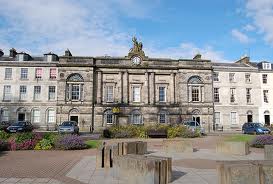
Above, Perth Academy.
Education in 18th century Scotland was delivered primarily by parish schools run by the Church. But, increasingly, more and more school children began receiving an education outside of the public system in what were known as private adventure schools in which the parents bore the cost and the Church had no say. As industrialization took hold in the 19th century, the migration of the peasant population to urban centers, and the arrival of large numbers of Irish immigrants, parish schools began to lose their ability to deliver instruction to students. Moreover, many parents were unable to afford the school fees or raise the money to go towards teacher fees and buildings in non-public education.
In Glasgow in 1857 for example, less than 50% of the students aged 5 to 10 were receiving education. The low attendance was a direct result of the demand for child labour. That demand was steadily increasing as poor parents were sending their children to earn rather than to learn. Even for the children who were attending school, the situation was a mess. The emphasis was on reading, writing and arithmetic. However, not everyone received proper instruction. Boys were taught in foreign and ancient languages while girls were generally restricted to learning domestic training. For girls, school and work were viewed as mere interludes on the road to marriage and child-rearing. Moreover, since domestic service was the largest employer for females, giving them domestic training in schools was widely seen as preparing them for work. Literacy expectations were low, namely: the ability to sign one's name on a marriage license, and on that test, the majority of Scottish girls and boys met the standard.
One result of these forces was the introduction of Sunday Schools as a way to supplement the parish system. Town councils began introducing these in the 1780s, and became standard fare for all denominations in the 1800s. By the 1830s and 1840s, these had widened to include various other forms of schooling including mission schools, Bible societies, and improvement classes. These were open to members of all forms of Protestantism and were most commonly found in urban centers as a way to provide education for the growing working classes.
School funding was a major issue. The Church was finding it difficult to provide education for the rapidly growing population and, as noted above, parents were also unable to meet fee expectations. Applications to the State for educational subsidies became increasingly common. However, with the subsidy came state inspections of those schools receiving grants. It became increasingly apparent that Scotland's educational system would collapse without the state aid. Various attempts were made in the 1850s and 60s to introduce a non-sectarian, publicly financed system but these failed to pass in Parliament due to the opposition of English MPs who feared that a similar system in England would lead to the loss of privileges of the Church of England. However, a commission into the state of Scottish Education in 1867 confirmed the deplorable state of education and Parliament was spurred into action.
The result was Scotland's Education Act of 1872 which took the control of education away from the churches (with a few exceptions) and put it into the hands of local popularly elected school boards. Overall administration was the responsibility of the Scottish Education Department. The act also mandated compulsory education for children aged 5 to 13 although some exemptions were allowed provided proficiency up to grade 5 could be demonstrated. The leaving age was raised to 14 in 1883.
With the new funding system in place, many new school-board supervised schools were built. The range of subjects that could be s studied in schools was also broadened. By the turn of the century, illiteracy had been eliminated on both the Highlands and the Lowlands and much was done to improve attendance rates.
The same free access to secondary education was not provided by the act. Attendance at these schools was closed to those who could not afford the fees and, as a result, the growing middle class was able to provide their children with education in advanced subjects such as modern languages and maths through attendance at these secondary schools/academies. The "Leaving Certificate Examination" was established in 1888 as a way to set national standards for secondary education but this did little to increase the numbers in these "higher class" schools. Even in 1992, when almost all secondary education became free and scholarships were more widely available, few working class children could take advantage of the opportunity Only 5% of Scottish children attended a secondary school in 1897. The real priority for the others was to find work and begin earning a wage.
Sources
History of Education in Scotland as found in Wikipedia. http://en.wikipedia.org/wiki/History_of_education_in_Scotland
A History of the Scottish People. by W. W. Knox. Chapter 1: The Scottish Educational System, 1840-1940. http://www.scran.ac.uk/scotland/pdf/SP2_1Education.pdf